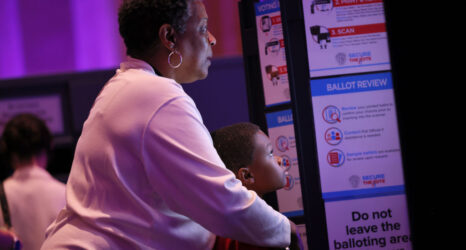San Francisco’s mayoral election this summer took an unusual turn when rivals Jane Kim, a member of the city’s Board of Supervisors, and Mark Leno, a former state senator, endorsed each other—before the primary votes for their party had been cast.
It’s common at the close of primary elections for two former rivals to shake hands and join forces against a candidate from another party—but not for two rivals to form alliances during the race in order to block a third candidate. In San Francisco, however, where Kim and Leno were facing off against a third candidate, London Breed, in a ranked choice election, commonalities may no longer stand.
Breed, the director of the Board of Supervisors, won the election despite the tactic—and although her opponents attempted to leverage the ranked choice system against her, it could also very well also be the reason she won.
Thank you Assemblymember @DavidChiu and all our volunteers who came out to our mobilization in Noe Valley this afternoon! #LondonForMayor pic.twitter.com/VRHu9fg1cI
— London Breed (@LondonBreed) May 27, 2018
In a ranked choice voting system, voters rank candidates from most to least preferred at their polling places instead of choosing just one to support. The candidate with the least votes is eliminated—and the second and third choice votes from those who ranked them first are distributed as appropriate to the candidates left standing. The process repeats itself until one candidate is the clear winner of the majority of votes.
Ranked choice voting challenges candidates to fight not just to be someone’s first and only choice for a position, but to be someone’s second or third as well. The system is meant to encourage candidates to form partnerships, and it pushes candidates to try and appeal to a wider variety of voters.
The alliance between Kim and Leno was not a defect of the ranked choice voting system—it was an asset. And its other features led to Breed’s historic victory.
“[Breed] was able to get second and third choice in communities who may not have wanted her first but were certainly willing to rank her second or third,” Cynthia Richie Terrell, a founder of Representation2020 and FairVote, explained to Ms.
Kim and Leno, meanwhile, bridged divides in their own party in the process. “That kind of civility,” Pedro Hernandez, deputy director of the group Fair Vote California, told The Atlantic, “instead of those two candidates knocking each other down, was exactly what ranked choice was made to do.”
The ranked choice system also creates new potential for a diverse range of candidates to see successes up and down the ballot, and it gives an unusual boost to feminist candidates. Because candidates in ranked choice elections succeed by reaching more voters—not just the people they know will agree with them—and have the potential to work in tandem with one another, personal attacks and bitterness could go by the wayside over time as well. Both features make the new system a perfect fit for the rise in women candidates nationwide.
“Women candidates, perhaps because they’re new to the political system, are less afraid seemingly to say to say hey, if I’m not going to be your first choice I hope I’m gonna be your second or third choice,” Terrell told Ms. “Constituencies may know that they helped put a candidate over the top, even if they don’t have a strong enough base of support to elect a candidate of their own—which is a good reason to have ranked choice voting in general, even if it doesn’t pertain specifically to women.”
Civility in elections, partnerships between candidates and new potentials for feminist candidates alone are features powerful enough to rock the political landscape—but this kind of reframing of our election system may also increase voter turnout and actually ease the confusion that faces voters making zero-sum decisions in crowded elections.
Maine has become the latest state to adopt ranked choice voting; across the country, cities like St. Paul, Minneapolis, and Santa Fe, New Mexico have also elected to do so. It would be naive to say that ranked choice voting in these regions alone will solve America’s voting crisis, or that the new system alone could do so—there remains much work to be done to combat voter suppression, gerrymandering and stagnation in civic engagement. But in due time, ranked choice voting could provide an opportunity for a wider variety of candidates—and voters—to make the political campaigns they want to see in their communities more possible.





